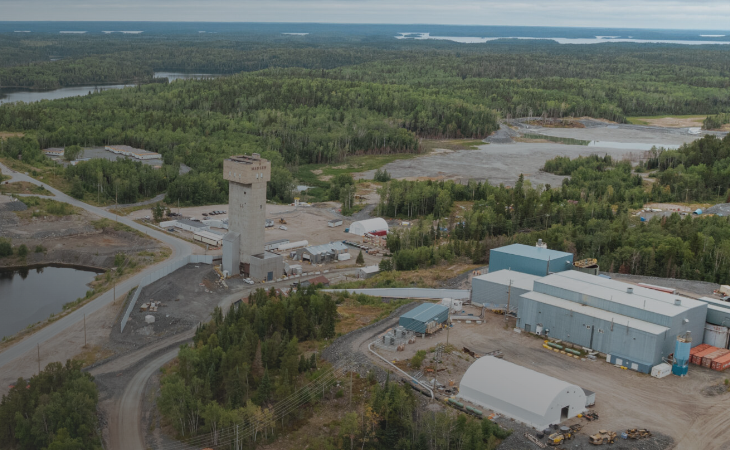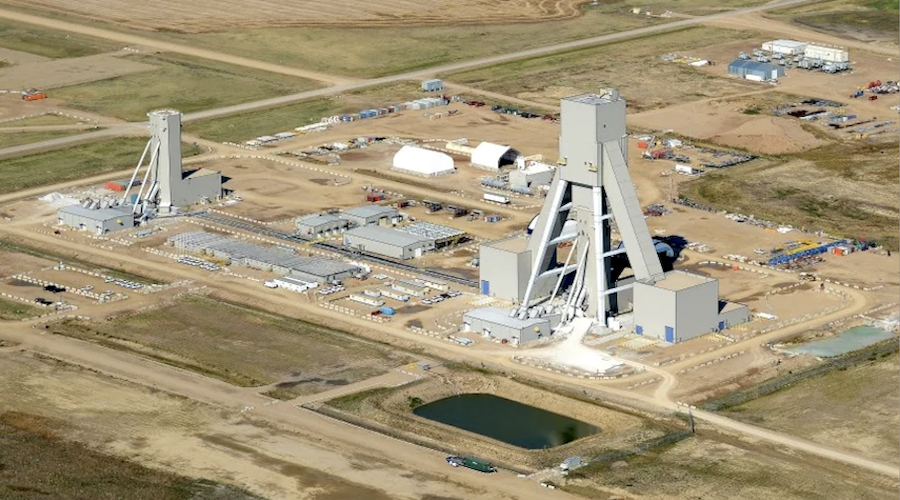VANCOUVER - Trevali Mining Corporation provides an update on the recommended paste backfill test work at its Caribou Zinc Mine in the Bathurst Mining Camp of New Brunswick, Canada.
There are 6.15 million tonnes grading 6.11% Zn, 2.49% Pb, 0.34% Cu, 67.8 g/t Ag and 0.86 g/t Au of estimated life-of-mine plant feed in the current Caribou mine re-start plan (see May 13th, 2014 news release TV-NR-14-07 and June 26, 2014 SRK Consulting PEA report "Technical Report on Preliminary Economic Assessment for the Caribou Massive Sulphide Zinc-Lead-Silver Project, Bathurst, New Brunswick, Canada"). Several of the key optimization opportunities and recommendations identified in the 2014 report include additional exploration drilling to fully define the Caribou geological system, which remains open for expansion, and the potential to maximize or increase the estimated life-of-mine plant feed by using paste backfill technology in particular to recover a significant portion of the 1.33 million tonnes of mineralization (comprised within the current resource) in the sill pillars that are currently excluded from the PEA mine plan.
Recent proof of concept exploration drill results clearly demonstrate that the Caribou deposit remains open for expansion - a 200-metre step-out drill hole intersected 50.9 metres of massive sulphide returning 5.08% Zn, 1.76% Pb, 0.37% Cu, 59.6 g/t Ag and 1.63 g/t Au (see April 16, 2015 news release NR-TV-15-07 for details).
POTENTIAL PASTE BACKFILL ADVANTAGES AT CARIBOU
Contingent on ongoing positive technical analysis, adoption and implementation of a paste backfill system at Caribou could have multiple advantages including:
Sill Pillars
The current mine plan utilizes dry waste-rock backfill, which due to its strength characteristics limits the estimated amount of the horizontal sills that can be recovered (Figure 1). Paste backfill, with its significantly superior strength and ground support characteristics, would allow extraction of a greater portion of tonnages currently 'locked' in these sills:
| Total sill pillar tonnage available | 1,931,000 tonnes |
| Current PEA mine plan sill tonnage extraction | 601,000 tonnes |
| Additional sill tonnage extraction range utilizing paste backfill | 717,000 to 1,330,000 tonnes |
To viewFigure 1,please visit the following link: http://media3.marketwire.com/docs/1003363-F1.pdf
Multiple Lens Zones
In areas of multiple zones, in particular at intermediate-to-deeper levels on the Caribou North Limb, it is estimated that up to 75% of the massive sulphide occurs in multiple lens zones. In order to maintain a stable, competent vertical pillar between these lenses, minimum stand-off distances are established to support the waste-rock fill that in turn can lead to lower mining recoveries (Figure 2).
Figure 2 illustrates an example where under the current waste-rock backfill method only one lens, Lens 2 in this case, can be safely extracted locally resulting in poor overall mining recovery of approximately 47% of the mineralization. Paste backfill, an engineered fill, would allow for additional recovery of the mineralized material locked up within the vertical pillars as the minimum stand-off distance can be reduced, the width of the vertical pillar can be reduced or alternatively the majority of the mineralization can be sequentially extracted to approach a more typical recovery of approximately 94% of the mineralization. Ongoing work will model the potential additional accessible tonnages available from these areas.
To viewFigure 2,please visit the following link: http://media3.marketwire.com/docs/1003363-F2.pdf
| • | Decreasing Waste Rock Dilution - Increasing Mill Head Grade |
| | The current mine plan includes 16% waste-rock dilution - paste backfill is estimated to decrease dilution to 8-10% thereby boosting overall head grade and metal units delivered to the mill. |
| | |
| | It may also add potential incremental tonnes to the mine plan, that is, tonnes currently not viable for a variety of reasons but typically those marginally below the cut-off-grade of the mine plan and contingent on commodity prices at time of extraction. |
| | |
| • | Improve Stope Cycle Time - Improved Efficiencies |
| | Utilization of paste backfill will decrease stope cycle times by an estimated 25-30% in addition to dropping backfill costs due to decreased re-handling of material and decreased mining fleet requirements. |
| | |
| • | Decreased Surface Tailings Requirements |
| | Paste backfill is estimated to conservatively reduce surface tailings volumes by 40-50%. |
| | |
| • | Facilitates Deeper Mining |
| | Longer term, as anticipated mining accesses the deeper portions of the deposit (which remains open for expansion), the strength and mining benefits of paste backfill increase proportionally and could ultimately render these areas viable versus a dry-waste backfill method. |
| | |
| • | Decreased Ventilation Requirements |
| | Paste backfill is delivered to post-mining open voids via a network of boreholes and pipes from a surface plant whereas waste-rock backfill is transported to voids using vertical raises and mobile diesel Load-Haul-Dump ("LHD") equipment. Paste backfill reduces the underground equipment (LHD's and truck) requirements, which in turn reduce the overall ventilation requirements in the mine. |
| | |
| • | Regional Ground Stability |
| | Faster cycle times and tight filling of voids with paste backfill improves the overall regional ground stability in the mine. |
ABOUT PASTE BACKFILL
In summary, paste backfill is a well-established mining industry method of utilizing the waste ground rock material from the mineral processing plant once metals have been extracted, adding various binding components to it and injecting it back underground into the post-mining open voids or stopes. It has multiple advantages over open voids or dry waste-rock backfill but principally its superior strength and ground support characteristics typically allows greater extraction of the mineral deposit, decreases dilution of extracted mineralization by lower grade or zero grade waste-rock material following blasting and decreases the size and footprint of surface tailings management facilities.
TESTWORK RESULTS
At Caribou, the paste backfill test work has been designed, supervised and conducted by Kovit Engineering, a Sudbury-based specialist in paste backfill consultancy. Testing, which is ongoing, utilized both historic and laboratory prepared tailings material. Results to date indicate that it is technically feasible to produce a paste backfill with the desired strength and flow characteristics from Caribou tailings material.
In summary, optimum results using a 5% binder addition achieved strengths between 700 and 1300 kPa at 7 days, 500-to-2500 kPa at 28 days and 250-to-850 kPa at 90 days. For reference, approxima
tely 400 kPa at 14 days is required for mining stability of the hanging and foot wall rock and paste fill face.
Phase I test work focused on 100% Caribou tailings feed with modest cement addition to achieve desired strength requirements. Three binder types were tested: 90:10 general use cement/slag, high-sulphide cement, and general use cement.
Phase II test work, most recently completed, examined the potential advantages of utilizing local sand deposits located on the Caribou property as part of the paste backfill process in order to further improve paste characteristics and decrease estimated capital expenditure requirements by decreasing paste plant filtering requirements.
The estimated capital expenditure from basic engineering for a new tailings-sand backfill plant including new equipment, installation and initial surface and underground distribution network is estimated to range from $9-12 million including a 30% contingency. Estimated operating expenditure for a paste-plant is estimated at $8.50 per tonne versus $13.50 per tonne for dry backfill in the current PEA report.
Phase III test work will involve more detailed follow-up and optimization of sand-paste characteristics, detailed geological fieldwork on several sand deposits located on the Caribou property (four of which have been identified from the Geological Survey of New Brunswick databases and records), larger-scale test work using 'fresh' tailings from the Caribou plant once commissioning commences and ongoing mine plan optimization of potential additional tonnages available.
Contingent on the above results, detailed stope optimization, cost-benefit analysis and detailed engineering will follow.
For more information, please visit www.trevali.com





Comments